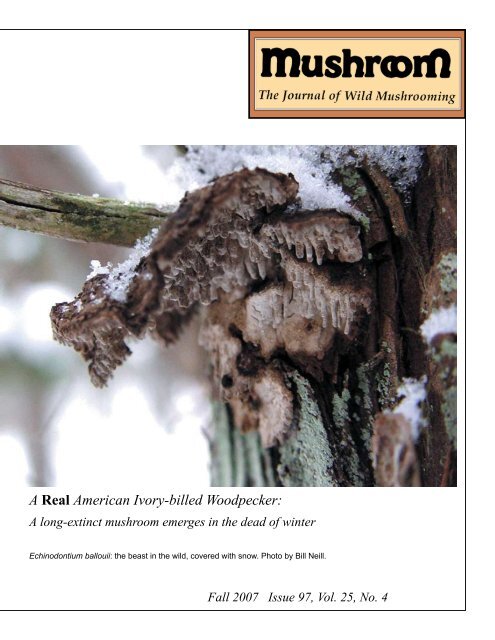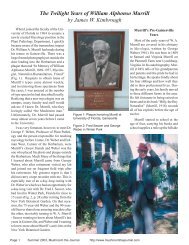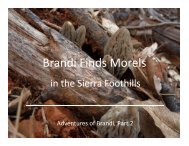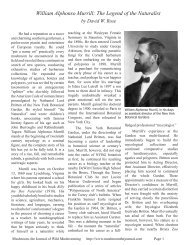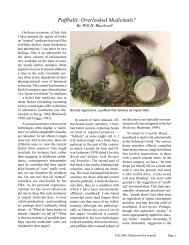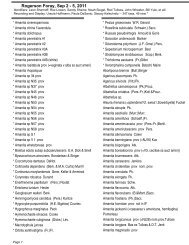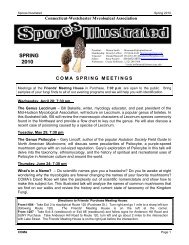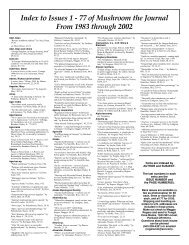Echinodontium ballouii - Mushroom, the Journal of Wild Mushrooming
Echinodontium ballouii - Mushroom, the Journal of Wild Mushrooming
Echinodontium ballouii - Mushroom, the Journal of Wild Mushrooming
You also want an ePaper? Increase the reach of your titles
YUMPU automatically turns print PDFs into web optimized ePapers that Google loves.
A Real American Ivory-billed Woodpecker:A long-extinct mushroom emerges in <strong>the</strong> dead <strong>of</strong> winter<strong>Echinodontium</strong> <strong>ballouii</strong>: <strong>the</strong> beast in <strong>the</strong> wild, covered with snow. Photo by Bill Neill.Fall 2007 Issue 97, Vol. 25, No. 4
<strong>Echinodontium</strong> <strong>ballouii</strong>: From Eyeballs to DNA, by Leon Shern<strong>of</strong>fFungal Classification: In <strong>the</strong>BeginningWay back in 1751, <strong>the</strong> Swedishbotanist Carol Linnaeus had great successwith a new system for classifyingplants – <strong>the</strong> system that is <strong>the</strong> basis <strong>of</strong><strong>the</strong> one that we use today. Much <strong>of</strong>Linnaeus’ success is <strong>of</strong>ten credited tohis invention <strong>of</strong> binomial nomenclature– <strong>the</strong> idea that each plant shouldbe referred to be a combination <strong>of</strong> agenus and species name. However, healso got a lot <strong>of</strong> mileage by categorizingplants according to how <strong>the</strong>y ran<strong>the</strong>ir sex lives – not just flower structure,as you might expect, but whe<strong>the</strong>reach flower had both male and femaleparts or whe<strong>the</strong>r <strong>the</strong>y were separated,and whe<strong>the</strong>r plants with separate maleand female flowers would bear <strong>the</strong>mon <strong>the</strong> same plant or whe<strong>the</strong>r <strong>the</strong>rewere separate male and female plants.He actually described <strong>the</strong>se criteria invery provocative terms: as whe<strong>the</strong>r <strong>the</strong>male and female parts were in <strong>the</strong> samebed or <strong>the</strong> same marriage chamber ornot, and he was roundly attacked by<strong>the</strong> fundamentalists <strong>of</strong> his time. Heusually responded by naming smallweeds after <strong>the</strong>m.Any successful system demandsexpansion, <strong>of</strong> course, and Linnaeuswas soon extending his system from<strong>the</strong> green plants that he was originallyinterested in to fungi, lichens and evenanimals. Linnaeus really knew hisplants, and his focus on sexual systemsworked really well for <strong>the</strong>m. Itworked much less well for fungi, bu<strong>the</strong> was pretty clueless about <strong>the</strong>m (hisfirst classification <strong>of</strong> fungi includedonly about a hundred altoge<strong>the</strong>r) soit didn’t bo<strong>the</strong>r him that much. Bythat time, people were pretty sure thatmushrooms reproduced by means <strong>of</strong>spores, so Linnaeus made a fungus’spore-bearing surface <strong>the</strong> basis <strong>of</strong> itsclassification and gave this surface <strong>the</strong>typically provocative name <strong>of</strong> ‘hymenium.’All mushrooms that bore <strong>the</strong>irspores on gills went into <strong>the</strong> genusAgaricus. All mushrooms with a honeycombedhymenium on a stalk wentinto <strong>the</strong> genus Phallus (ano<strong>the</strong>r typicalLinnaeus name), which sounds familiaruntil you realize that <strong>the</strong> morelswent in <strong>the</strong>re, too. So <strong>the</strong> first name for<strong>the</strong> morel under Linnaeus’ system wasPhallus esculenta, <strong>the</strong> edible phallus;no wonder <strong>the</strong> fundamentalists weredisturbed.Luckily, help was on <strong>the</strong> way. In<strong>the</strong> 1790s, Christian Hendrik Persoonstarted shaking things up a bit, andin 1821 Elias Magnus Fries redid <strong>the</strong>classification <strong>of</strong> fungi in a major way.He separated <strong>the</strong> morels from <strong>the</strong> stinkhornsand liberated <strong>the</strong> chanterellesfrom <strong>the</strong> strange spot that Linnaeushad stuck <strong>the</strong>m. Linnaeus had created<strong>the</strong> genus Merulius for fungi with anirregularly wrinkled hymenium – whenmany <strong>of</strong> you learned your mushrooms,you learned Merulius as a group <strong>of</strong>wrinkly jelly-like things that lie flat(resupinate) on wood. Because chanterellesalso have a wrinkly hymenium,Linnaeus decided that <strong>the</strong>y weresomehow closely related and it wasup to Fries to separate <strong>the</strong>m. Fries alsoseparated <strong>the</strong> polypores from <strong>the</strong> boletes– Linnaeus had put all <strong>the</strong> “poredfungi” toge<strong>the</strong>r – and Fries later supported<strong>the</strong> division <strong>of</strong> polypores int<strong>of</strong>ur<strong>the</strong>r categories like Fomes (for <strong>the</strong>hard, woody, perennial conks), using“polypores” as a larger-scale categorythat included all <strong>the</strong>se new genera.Fries brought a lot <strong>of</strong> common sense to<strong>the</strong> classification <strong>of</strong> fungi. But he wasstill working within <strong>the</strong> basic outlines<strong>of</strong> Linnaeus’ system, just with fur<strong>the</strong>rrefinements.So a hundred years ago, when <strong>Echinodontium</strong><strong>ballouii</strong> was discovered,fungi were still primarily categorizedaccording to <strong>the</strong> structure <strong>of</strong> <strong>the</strong>ir hymenium– whe<strong>the</strong>r it was composed<strong>of</strong> gills, pores, spines, or somethingharder to categorize. Within <strong>the</strong>sebroad categories, mushrooms were<strong>the</strong>n broken down into genera on <strong>the</strong>basis <strong>of</strong> whe<strong>the</strong>r <strong>the</strong>y had a cap, a stem,or whe<strong>the</strong>r <strong>the</strong>y were just resupinate(lying flat on what <strong>the</strong>y were growingon).When Ballou sent Howard JamesBanker at <strong>the</strong> New York BotanicalGarden his first specimens <strong>of</strong> <strong>Echinodontium</strong><strong>ballouii</strong>, Banker placed it in<strong>the</strong> genus Steccherinum. Steccherinumwas a sort <strong>of</strong> catch-all genus for fungiwith a spiny hymenium and a capbut no stem. O<strong>the</strong>r people disagreedwith Banker and placed Ballou’s findin o<strong>the</strong>r genera, and it didn’t end upin <strong>Echinodontium</strong> until 1964, whenHenry Louis Gross took a comprehensivelook at <strong>the</strong> genus <strong>Echinodontium</strong>and pointed out how closely it fit in.The genus is based on E. tinctorium,which has some unique features – <strong>the</strong>thick cluster <strong>of</strong> spore-bearing spines,and <strong>the</strong> brightly-colored flesh – so ittook <strong>the</strong> work <strong>of</strong> Henry Louis Grossto point out that <strong>the</strong> o<strong>the</strong>r <strong>Echinodontium</strong>s– most <strong>of</strong> <strong>the</strong>m less spiny andmore dully colored – were so similarto it microscopically.Morphology, <strong>the</strong>n and nowWhat features merit inclusion ina genus? The mycological consensuson this has changed drastically in <strong>the</strong>last fifty years. Linnaeus started us <strong>of</strong>fwith an approach based on morphology:in broad terms, simply how <strong>the</strong>mushroom is shaped. His approachwas very much based on <strong>the</strong> nakedeye – and, I might add, what <strong>the</strong> nakedeye can taken in quickly. My favoriteexample is an example from his firstclassification <strong>of</strong> <strong>the</strong> fungi: Agaricus(Russula) rubra, where Russula is asubgenus that was later raised to genuslevel. Yes, rubra means red, andhis treatment amounts to giving allred-capped Russulas, everywhere, <strong>the</strong>same name. In fact, <strong>the</strong>re are probablyalmost a hundred red-capped RussulasPage2Fall 2007, <strong>Mushroom</strong> <strong>the</strong> <strong>Journal</strong>
in North America alone, and probablya dozen just in Linnaeus’ native Sweden.But to Linnaeus, <strong>the</strong>y were all justred Russulas, Russula rubra. 1Persoon and Fries brought moresophistication to <strong>the</strong>ir classificationsystems. and during <strong>the</strong>ir lifetime moreand more microscopic features wereincluded in descriptions <strong>of</strong> fungi – extending<strong>the</strong> concept <strong>of</strong> morphology to<strong>the</strong> microscopic level. Fries also triedto use developmental features as one<strong>of</strong> <strong>the</strong> criteria for a genus. He didn’tdo a very good job <strong>of</strong> it, but by <strong>the</strong>mid-20th century, some mycologistsadvocated taking microscopic anddevelopmental features into accountin fungal classification.When Gross monographed <strong>the</strong>genus <strong>Echinodontium</strong> in 1964, he didsomething that was at that time quite“modern” and daring: he included <strong>the</strong>two species <strong>of</strong> <strong>the</strong> white crusty genusLaurilia. Why? There are a variety <strong>of</strong>reasons. The illustrations below showsa microscopic view <strong>of</strong> <strong>the</strong> hymenium<strong>of</strong> <strong>Echinodontium</strong> tinctorium and Lauriliasulcata, <strong>the</strong> species upon whichboth genera are based. These illustrationsare taken from Gross’ paper. BothMicroscopic view <strong>of</strong> Bill and Larry’s <strong>Echinodontium</strong> <strong>ballouii</strong> specimen,showing an encrusted thick-walled cystidium (long cell in <strong>the</strong> middle) . The<strong>the</strong> spores with slight bumpy amyloid ornamentation didn’t photograph aswell,fungi have thick-walled cystidia thatare encrusted with crystals. Cystidiaare cells that protrude from <strong>the</strong> mainbody <strong>of</strong> <strong>the</strong> fungus out into <strong>the</strong> hymenium.Since <strong>the</strong>y seem to evolve quiterapidly, such a strong similarity incystidia has been considered a marker<strong>of</strong> evolutionary relatedness. The hyphaewith <strong>the</strong> thickened walls, by <strong>the</strong>way, are what stiffen <strong>the</strong> fruiting bodyand give it its woody (E. tinctorium)or tough (L. sulcata) texture. GrossThe hymenium <strong>of</strong> <strong>Echinodontium</strong> tinctorium and <strong>Echinodontium</strong> (= Laurilia) sulcatum, from Gross’ 1964 paper.In each illustration, a and b are thick-walled, crystal-encrusted end-cells, a protruding as cystidia and b gettingready to. C are <strong>the</strong> basidia, <strong>the</strong> spore-bearing cells <strong>of</strong> <strong>the</strong> hymenium, and d are <strong>the</strong> spores <strong>the</strong>mselves, coveredin tiny amyloid bumps.1True, to many <strong>of</strong> us <strong>the</strong>y’re also all just red Russulas! But we’re not posing as scientists when we feel that way.Fall 2007, <strong>Mushroom</strong> <strong>the</strong> <strong>Journal</strong> Page 3
also emphasized a developmentalfeature: that <strong>the</strong>se fungi are perennial,and form each year’s new hymeniumby growing it directly on top <strong>of</strong> lastyear’s. If you cross-section each <strong>of</strong><strong>the</strong>se mushrooms, you’ll see a set <strong>of</strong>growth layers outlined in <strong>the</strong> flesh, like<strong>the</strong> growth rings on a tree, each parallelto <strong>the</strong> one before, outlining <strong>the</strong> sameset <strong>of</strong> teeth, or (in <strong>the</strong> case <strong>of</strong> Laurilia)<strong>the</strong> same set <strong>of</strong> random bumps ando<strong>the</strong>r irregularities. Gross noted that<strong>the</strong> spore-bearing spines <strong>of</strong> <strong>the</strong>se fungithus get thicker each year, and in <strong>the</strong>case <strong>of</strong> E. tinctorium <strong>the</strong> spines eventuallygrow into one ano<strong>the</strong>r, startingfrom <strong>the</strong> base outward. The spines in<strong>the</strong> specimen <strong>of</strong> E. tinctorium picturedhere seem to have grown toge<strong>the</strong>r quitea bit. But, Gross said, if you cut <strong>the</strong>conk down <strong>the</strong> middle, you can stillsee <strong>the</strong> outlines <strong>of</strong> where each previousyear’s growth <strong>of</strong> each spine occurred,embedded in <strong>the</strong> now-solid flesh.All <strong>of</strong> this sounds like what manyo<strong>the</strong>r conks do: don’t <strong>the</strong> big Fomesand Phellinus species also form newlayers <strong>of</strong> pores each time <strong>the</strong>y sporulate?Well, <strong>the</strong>y do, and <strong>the</strong>y alsoexhibit “growth rings” in cross section,but with <strong>the</strong>m, <strong>the</strong> next layer <strong>of</strong>pores comes from hyphae growing upthrough <strong>the</strong> previous layer <strong>of</strong> poresfrom <strong>the</strong> main body <strong>of</strong> <strong>the</strong> fungus.Gross emphasized 2 that after eachhymenium <strong>of</strong> a polypore sporulates, itbasically dies, so <strong>the</strong> next wave <strong>of</strong> poreformation comes from hyphae from <strong>the</strong>main body <strong>of</strong> <strong>the</strong> fungus growing downthrough <strong>the</strong> existing pore openingsand forming a new pore layer on top<strong>of</strong> <strong>the</strong>m. In <strong>the</strong> <strong>Echinodontium</strong>s, <strong>the</strong>older hymenium stays alive and growsa new one directly on top <strong>of</strong> itself. Healso emphasized 3 that in polypores,<strong>the</strong> hymenium will correct for previouserrors and try to present <strong>the</strong> poreopenings on a smooth horizontal plane.For instance, if <strong>the</strong> conk has to growaround a branch at some point, this maydistort <strong>the</strong> pore layers that enclose <strong>the</strong>branch, but once it has grown past <strong>the</strong>branch, <strong>the</strong> pore layers will becomeregular again. Not so in <strong>Echinodontium</strong>and Laurilia – each irregularity <strong>of</strong> <strong>the</strong>hymenium is perpetuated in subsequentlayers.There were also more subtle similarities,difficult to put into words. Forinstance, when <strong>the</strong> Japanese mycologistRokuya Imazeki was describing his newfind, <strong>Echinodontium</strong> tsugicola in 1935,he mentioned that its white, tough andirregularly bumpy upper surface lookedexactly like that <strong>of</strong> Laurilia sulcata.It’s hard to formalize a similarity likethat, and make it part <strong>of</strong> a system, butit impressed Imazeki enough that hefelt obliged to mention it, and Gross<strong>of</strong> course felt that this was significantalso. 4All <strong>of</strong> this adds up to a pretty hefty set<strong>of</strong> similarities; why were <strong>the</strong> <strong>Echinodontium</strong>and Laurilia species ever put in differentgenera? Because <strong>the</strong> two Lauriliaspecies have a “smooth” spore-bearingsurface, without regular structures <strong>of</strong><strong>the</strong> types (such as gills, teeth, pores)that were <strong>the</strong>n <strong>of</strong>ficially recognized.Linnaean/Friesian mycology, <strong>the</strong> firstsystematic approach to <strong>the</strong> classification<strong>of</strong> <strong>the</strong> fungi, emphasized <strong>the</strong> shape <strong>of</strong><strong>the</strong> hymenium and made its major divisions<strong>of</strong> fungal classification accordingto its shape – gills versus pores versusspines and so on. Laurilia sulcata thusstarted out its scientific career in 1901as Stereum sulcatum, where Stereum is<strong>the</strong> old general-purpose genus for fungiwhose hymenium is “smooth.” Now,in fact, its hymenium is anything butsmooth – it is covered with all sorts <strong>of</strong>irregular bumps, protrusions and folds.But Edwin Angus Burt, who named it,felt that this should get recognition at <strong>the</strong>species level, not <strong>the</strong> genus level: sulcatameans “folded.”2and he may have been wrong in making such a sweeping generalization about <strong>the</strong> polypores3and here I think he was more correct in making a distinction4Gross p. 3.Does Morphology IncludeChemistry?At <strong>the</strong> time that Gross wrote hispaper, chemical features were beingadded to microscopic and developmentalones in determining which fungiwere related to which. For instance,around <strong>the</strong> same time as Gross’s paper,Rolf Singer placed <strong>the</strong> genus <strong>of</strong> hugepolypores, Bondarzewia, in with <strong>the</strong>Russulas and Lactarius in his classificationsystem, because all threegenera possess a unique type <strong>of</strong> spore:one having amyloid ridges or flanges.“Amyloid” is <strong>the</strong> fungal-speak term formushroom parts (usually microscopic)that have a starchy structural component,and so turn black when exposedto iodine. It’s not particularly rare forfungi to have an amyloid spore wall,but it is quite unusual for a fungus tohave an inamyloid spore wall withamyloid ornamentation, as <strong>the</strong>se do.Amyloidity, as it has turned out, is animportant feature in <strong>the</strong> group <strong>of</strong> mushroomsthat includes <strong>Echinodontium</strong>.And at <strong>the</strong> same time, <strong>the</strong> Dutchmycologist Marinus Donk was ponderingwhe<strong>the</strong>r to include <strong>the</strong> delicatelyspinedgenus Hericium in <strong>the</strong> samegroup with Lactarius, Russula andBondarzewia, because some <strong>of</strong> <strong>the</strong>hyphae in Hericium contain a latexsimilar to that in Lactarius (although<strong>the</strong> Hericium species never containenough to exude “milk”, <strong>the</strong> way <strong>the</strong>Lactarius species do). In 1971, Donkwould be <strong>the</strong> first to propose that all<strong>the</strong> fungi now known as <strong>the</strong> Russulalesbe grouped toge<strong>the</strong>r because <strong>of</strong> <strong>the</strong>selatex-containing hyphae.But this sort <strong>of</strong> thing was slowto catch on. Already, in 1959, <strong>the</strong>Czech mycologist Zdenek Pouzardecided to create <strong>the</strong> genus Laurilia,because he felt that <strong>the</strong> fungi with encrustedcystidia and such an irregularspore-bearing surface deserved to beseparated from <strong>the</strong> more ‘ordinary’Page4Fall 2007, <strong>Mushroom</strong> <strong>the</strong> <strong>Journal</strong>
Spore-bearing spines, <strong>the</strong> ‘old view’ <strong>of</strong> fungal evolution. Starting at <strong>the</strong> top right and travelling clockwise, we can see<strong>the</strong> spore-bearing spines <strong>of</strong> <strong>the</strong>se fungi getting longer, thinner and more sophisticated. Alas, it’s not really so!Top right: Laurilia sulcata (photo courtesy <strong>of</strong> Scott Redhead and Jim Ginns) shows us <strong>the</strong> process just getting started– here we have a simple roughening <strong>of</strong> <strong>the</strong> fertile surface. Continuing clockwise, we have a photo <strong>of</strong> <strong>Echinodontium</strong>ryvardenii, taken by Cristina Spinelli. Here <strong>the</strong> spines, stalactite-like, are just beginning to extend downward from<strong>the</strong> cap. Lower right, <strong>the</strong> dense but thick and short spines <strong>of</strong> <strong>Echinodontium</strong> tinctorium, photo courtesy <strong>of</strong> Bill Neill.At top left, we see <strong>the</strong> thin, dense style <strong>of</strong> spore-producing spines that was thought to be ‘most highly evolved.’ It isclear that this style <strong>of</strong> spore-bearing creates much more surface area than <strong>the</strong> o<strong>the</strong>r fungi on this page do, but <strong>the</strong>DNA evidence says that <strong>the</strong>y’re actually not more recently evolved than <strong>the</strong> o<strong>the</strong>r fungi on this page.. This photo<strong>of</strong> a Hericium was taken by John Denk only a few weeks before this magazine came out.Stereums. But he didn’t take <strong>the</strong> nextstep that Gross took and look to see if<strong>the</strong>re was already ano<strong>the</strong>r place to put<strong>the</strong>m – one where <strong>the</strong>y fit accordingto microscopic and developmentalfeatures, but not according to sporebearingsurface. So most mycologistshave not gone along with Gross’ transfer<strong>of</strong> Pouzar’s Laurilia species into<strong>Echinodontium</strong>.An Attractive but IncorrectPicture <strong>of</strong> EvolutionIf one accepts Laurilia and <strong>Echinodontium</strong>as being in <strong>the</strong> same evolutionarygroup <strong>of</strong> fungi, one can mapout a very smooth and convincing transitionfrom “primitive” to “advanced”spore-bearing surfaces, as you can seefrom <strong>the</strong> sequence <strong>of</strong> pictures above.From Laurilia, which is bumpy andirregular but doesn’t have anythingon it that you could call an organizedstructure, one moves to E. ryvardenii,which seems to have developed some<strong>of</strong> Laurilia’s little bumps into real stalactites.Then it’s on to E. tinctorium,which has a whole bunch <strong>of</strong> stalactites,and finally <strong>the</strong> fine-too<strong>the</strong>d Hericium,which would represent admirablemodern efficiency.However, now we also have DNAevidence, which has turned everythingon its head.Fall 2007, <strong>Mushroom</strong> <strong>the</strong> <strong>Journal</strong> Page 5
We are lucky in that <strong>Echinodontium</strong>ryvardenii was discovered justin time to be included in a huge DNAsequencing project, Assembling <strong>the</strong>Fungal Tree <strong>of</strong> Life (AFTOL). In fact,it arrived in time to be included in a2003 paper by Ellen Larsson and Karl-Henrik Larsson on <strong>the</strong> Russulales, <strong>the</strong>large-scale taxonomic group that alsoincludes Russula and Lactarius. A laterpublication in <strong>the</strong> <strong>of</strong>ficial unveiling <strong>of</strong><strong>the</strong> AFTOL results three years laterwas very much <strong>the</strong> same, and <strong>the</strong> monstrosityon <strong>the</strong> next page is a schematicview <strong>of</strong> <strong>the</strong>ir results, incorporatingfeatures from both papers. 5To make it easier to find <strong>the</strong> fewspecies that we’re really interestedin, I’ve put pictures <strong>of</strong> <strong>the</strong>m by <strong>the</strong>irnames. The taxa are color-coded by<strong>the</strong>ir type <strong>of</strong> hymenium and fruitingbody:Resupinate formspores redspinesbluesmooth magentaForms with caps or branchespores orangespinesgills blackcoralloidgreenpurpleFrom this, you can see <strong>the</strong> greatdiversity <strong>of</strong> hymenial surface andfruiting body form in <strong>the</strong> Russulales.In this and <strong>the</strong> interweaving <strong>of</strong> differenthymenium and fruiting body typeswithin <strong>the</strong> same derived group, we findmore confirmation that <strong>the</strong> older view<strong>of</strong> evolutionary relationships – that<strong>the</strong>y are indicated simply by hymeniumtype – is incorrect. For example,not only are Laurilia sulcata and <strong>Echinodontium</strong>tinctorium as close as canbe, but <strong>the</strong> two o<strong>the</strong>r fungi in <strong>the</strong> samegroup with <strong>the</strong>m are Heterobasidionannosum, a hard, extremely fine-pored(i.e. sophisticated-looking) “polypore”that from looking at it appears to bejust a typical conk, and Bondarzewiaberkeleyii, a huge floppy thing that isalso pored but grows on <strong>the</strong> ground, isfleshy ra<strong>the</strong>r than hard, and has poresthat break apart and become maze-likein age. Three different types <strong>of</strong> hymenium,and a great difference in featuresbetween <strong>the</strong> two poroid species.Likewise, nutritional lifestyledoesn’t seem to be a good mid-scaleindicator <strong>of</strong> relatedness – <strong>the</strong> fungijust named are mostly wood-rotters,including <strong>the</strong> virulent “pest” <strong>of</strong> timber,Heterobasidion annosum; but Bondarzewiaberkeleyii is mycorrhizal,and a neighboring group includes <strong>the</strong>mycorrhizal genus Albatrellus.The placement <strong>of</strong> names requiresa little explanation. As one moves to<strong>the</strong> left in <strong>the</strong> chart, one is movingbackwards in time. The vertical blackline running down <strong>the</strong> left-hand side<strong>of</strong> <strong>the</strong> chart is called <strong>the</strong> backbone.It connects to <strong>the</strong> presumed singleancestor (<strong>the</strong> black line leading <strong>of</strong>f to<strong>the</strong> left) <strong>of</strong> <strong>the</strong> group as a whole, andrepresents <strong>the</strong> initial radiating <strong>of</strong> thissingle ancestor into different species.These newer species are said to bederived from it, and <strong>the</strong> newer speciesthat have evolved from <strong>the</strong>m are evenmore derived.Most <strong>of</strong> <strong>the</strong> branches coming <strong>of</strong>f<strong>the</strong> backbone lead to groups <strong>of</strong> varyingsize. For instance, near <strong>the</strong> top, beside<strong>the</strong> picture <strong>of</strong> <strong>Echinodontium</strong> ryvardenii,is a node labeled “Gloeocystidiellum5”. This means that <strong>the</strong> originalchart has five species <strong>of</strong> Gloeocystidiellumin this position. Larger groupsusually contain more than one genus <strong>of</strong>fungi; in this case, each genus is listedin turn, separated by a plus sign. Wherea species had no discernable relativesamong <strong>the</strong> o<strong>the</strong>r fungi sampled forthis project, it is connected directly to<strong>the</strong> backbone. In cases where a genusappears in separate locations within agroup, it is listed only once but withslashes between <strong>the</strong> number <strong>of</strong> speciesat each appearance – for instance“Aleurodiscus 2/1” means that <strong>the</strong>reare two Aleurodiscus species presentat one point in <strong>the</strong> group, and ano<strong>the</strong>rone by itself later on, with species fromo<strong>the</strong>r genera in between.Thus, ano<strong>the</strong>r thing shown by <strong>the</strong>chart is how many <strong>of</strong> <strong>the</strong> more poorlyunderstood genera are really a randomcollection <strong>of</strong> unrelated species. Scytinostromellaand Wrightoporia seemto be <strong>the</strong> champions in that regard.These are resupinate genera – Scytinostromellahas a smooth hymeniumand Wrightoporia is pored – that aredefined by having dextrinoid thickenedstructural hyphae and crystallinebumps on <strong>the</strong>ir regular hyphae. Thiscombination <strong>of</strong> features seems to beabsolutely meaningless as a way toindicate evolutionary relationships.The champion for being scatteredamong different groups, however, isGloeocystidiellum, which appears infour different groups, and within one<strong>of</strong> <strong>the</strong>m in four different places. Itscriteria <strong>of</strong> prominent latex-containingcystidia is not meaningless, however,as <strong>the</strong> species fulfilling this criteriaare <strong>of</strong>ten grouped in clumps. What itdoes show is that prominent latex-containingcystidia seem to have evolvedindependently several times.Horizontal position in <strong>the</strong>se chartsusually indicates when somethingevolved – <strong>the</strong> far<strong>the</strong>r to <strong>the</strong> left a speciesis, <strong>the</strong> longer ago it evolved. Inthis chart, that dimension is almostmeaningless, since <strong>the</strong> relation <strong>of</strong> eachgroup to <strong>the</strong> backbone – and to eacho<strong>the</strong>r – is so poorly defined. The chartdepicts <strong>the</strong> larger groups as startingmore to <strong>the</strong> left, but that’s somethingthat’s forced by <strong>the</strong> fact that within5For those <strong>of</strong> you who wish to look at <strong>the</strong> original charts and original papers, <strong>the</strong> citations are provided at <strong>the</strong> end <strong>of</strong> this article. Youshould be able to find Mycologia (where most <strong>of</strong> <strong>the</strong>se articles were published) in any college library; or, for those <strong>of</strong> you with an internetconnection, most <strong>of</strong> <strong>the</strong>se papers (as well as many additional ones) can be downloaded from David Hibbett’s website: http://www.clarku.edu/faculty/dhibbett/publications.html. He was an author on almost all <strong>of</strong> <strong>the</strong>m.Page6Fall 2007, <strong>Mushroom</strong> <strong>the</strong> <strong>Journal</strong>
Warning: Only <strong>the</strong> prefixes formany <strong>of</strong> <strong>the</strong>se fungal names makesense, not <strong>the</strong> names <strong>the</strong>mselves.Details are provided on page 7and 9....
each group something had to come first, so in alarger group that first something gets shoved fur<strong>the</strong>rback in line. The smaller groups could each be veryrecent or very ancient – <strong>the</strong>re’s no way to tell from<strong>the</strong> data in <strong>the</strong> study. 6This use <strong>of</strong> “basal” and “derived” gets us awayfrom <strong>the</strong> older style <strong>of</strong> talking about more “primitive”and “advanced” fungi, which is preferable fortwo reasons: first <strong>of</strong> all, this isn’t obvious from mychart, which has horizontally compressed things abit, but in <strong>the</strong> original pretty much everything in itis about equally derived – in fact very much so – or<strong>of</strong> unknown placement. One way you can see thison <strong>the</strong> chart is that <strong>the</strong>re’s no group <strong>of</strong> fungi withano<strong>the</strong>r group coming out <strong>of</strong> it. So <strong>the</strong>re isn’t reallya spread <strong>of</strong> taxa over enough evolutionary time tomake <strong>the</strong> older labels – “primitive” and “advanced”– meaningful.Second, you can see that <strong>the</strong> flat, resupinatehymenium that was formerly thought to be a “primitive”state (shown in magenta on <strong>the</strong> chart) is presentall over <strong>the</strong> place, in groups alongside fungi with amore structured one. So that old notion goes down<strong>the</strong> tubes also.The first thing that strikes one is <strong>the</strong> poor quality– or more precisely, <strong>the</strong> non-usefulness – <strong>of</strong>some <strong>of</strong> <strong>the</strong> data. There are seven isolated speciesthat are connected directly to <strong>the</strong> backbone, whichmeans we have no idea whatsoever <strong>of</strong> <strong>the</strong>ir relatednessto anything else in <strong>the</strong> chart. If we add to <strong>the</strong>se<strong>the</strong> two species <strong>of</strong> Aleurocystidiellum towards <strong>the</strong>bottom, which <strong>the</strong> authors especially single out asbeing unusually unrelated to all <strong>the</strong> o<strong>the</strong>r groups,and <strong>the</strong> strange duo <strong>of</strong> a Scytinostromella and aWrightoporia species in <strong>the</strong> next-to-last position,we have eleven species that are essentially floatingfreely within <strong>the</strong> chart, with no indication <strong>of</strong> <strong>the</strong>irrelations to any o<strong>the</strong>r taxa. This is just under 10%<strong>of</strong> <strong>the</strong> total number <strong>of</strong> species sampled.This is not a criticism <strong>of</strong> <strong>the</strong> quality <strong>of</strong> work that<strong>the</strong>se scientists did – it is perfectly possible that <strong>the</strong>6Presumably vertical position in <strong>the</strong> chart means something,but it’s not clear what, and <strong>the</strong> authors do not discuss this.So it’s not clear, for example, among <strong>the</strong> species that areconnected directly to <strong>the</strong> backbone, why <strong>the</strong>re’s a cluster <strong>of</strong>four <strong>of</strong> <strong>the</strong>m at <strong>the</strong> top <strong>of</strong> <strong>the</strong> chart, and one at <strong>the</strong> bottom.There is only one by itself in <strong>the</strong> middle in <strong>the</strong> original chart– Pseudoxenasma verrucisporum. Scytinostromella cerinais mentioned in <strong>the</strong> original text as connecting directly to<strong>the</strong> backbone, but <strong>the</strong> authors didn’t include it in <strong>the</strong>ir chart.I stuck it in at this arbitrary location because its presencesupports a couple <strong>of</strong> observations I want to make.127 species that make up <strong>the</strong> original tree are less than 1% <strong>of</strong> all<strong>the</strong> currently existing Russulales; so it should not be surprising tosee that some <strong>of</strong> <strong>the</strong> taxa sampled have not had any near neighborsincluded. This work is preliminary, and even <strong>the</strong> follow-up workwill remain preliminary for some time.A more troubling problem is <strong>the</strong> poor resolution at <strong>the</strong> middlelevel <strong>of</strong> detail – between <strong>the</strong>se small groups and <strong>the</strong> backbone.We have good resolution <strong>of</strong> <strong>the</strong> smaller groups that I have shownas single nodes in my schematic, and we are quite confident thatall <strong>the</strong> fungi shown belong in <strong>the</strong> Russulales. However, we havehardly any information at all about how each group relates to one<strong>the</strong> o<strong>the</strong>r ones.This is a consequence <strong>of</strong> <strong>the</strong> two DNA areas that were sequencedto provide <strong>the</strong> data. These were two locations sequenced in <strong>the</strong>fungi’s ribosomal DNA: <strong>the</strong> first is <strong>the</strong> nuclear large subunit rDNA,which is thought to evolve fairly slowly, and so is used to broadlyposition a species in <strong>the</strong> fungal tree. The second is <strong>the</strong> so-calledITS region, which consists <strong>of</strong> two non-coding spacer regions and<strong>the</strong> 5.8S rDNA gene. Since spacer regions don’t code for anything(<strong>the</strong>y just separate coding genes), mutations are thought toaccumulate more rapidly so this locus is used to compare closelyrelated species. Unfortunately, <strong>the</strong> effect <strong>of</strong> using <strong>the</strong>se two locationsis to give us good small-scale and whole-group resolution,but to leave <strong>the</strong> middle-ground almost blank. This is a shame,because <strong>the</strong> middle-ground should have been <strong>the</strong> most valuablepart <strong>of</strong> such a survey.There are those who will say, “No, no! It’s <strong>the</strong> small-scaledetail which is valuable,” but really, if we want to do small-scalework on <strong>the</strong> Russulas, we’ll sample more than five species, andundoubtedly at more than <strong>the</strong>se two DNA locations.These are <strong>the</strong> same two locations that were used for <strong>the</strong> wholelarge-scale AFTOL project: a decision was made to limit <strong>the</strong> sequencingto <strong>the</strong>se two, in order to sequence <strong>the</strong> fungi uniformlyacross <strong>the</strong> whole project. In addition to this desire for compatibilitybetween <strong>the</strong> results <strong>of</strong> all <strong>the</strong> branches <strong>of</strong> <strong>the</strong> project, <strong>the</strong>re was alsoa practical consideration. First <strong>of</strong> all, <strong>the</strong>se were two <strong>of</strong> <strong>the</strong> firstlocations discovered to be useful in sequencing fungal DNA, so<strong>the</strong>y have been used more than any o<strong>the</strong>rs which means that <strong>the</strong>y’vebeen obtained from more fungi. Work that was done a while agomeans less work to do now.Secondly, using only two locations made <strong>the</strong> project moremanageable, and even so it was five years late (and I think we stilldon’t have <strong>the</strong> results from <strong>the</strong> Polyporales). But it’s time to getworking on more locations, and get <strong>the</strong> middle-ground <strong>of</strong> <strong>the</strong> Russulalesresolved. As it is, <strong>the</strong> most valuable results <strong>of</strong> <strong>the</strong> survey areto show that many <strong>of</strong> <strong>the</strong>se resupinate genera are badly defined, and<strong>the</strong> function <strong>of</strong> including things like those five Russula species isin effect to calibrate <strong>the</strong> system – to show that <strong>the</strong> procedure doesin fact produce <strong>the</strong> results that we were dead certain <strong>of</strong> already, so<strong>the</strong> surprising ones are probably correct also.Page8Fall 2007, <strong>Mushroom</strong> <strong>the</strong> <strong>Journal</strong>
Back to <strong>the</strong> Fungus at HandWell, enough <strong>of</strong> this analysis <strong>of</strong> <strong>the</strong>study. Let’s see what help it gives uswith <strong>the</strong> fungi we’re most interestedin at <strong>the</strong> moment.First <strong>of</strong> all, it takes that tidily linkedevolutionary chain that I outlined inphotos a while ago and blows it out<strong>of</strong> <strong>the</strong> water. Two <strong>of</strong> <strong>the</strong> fungi thatwe’ve been discussing as being part<strong>of</strong> that sequence, Laurilia sulcata and<strong>Echinodontium</strong> tinctorium (towards<strong>the</strong> bottom), turn out to be sister taxa,at exactly <strong>the</strong> same level <strong>of</strong> evolutionaryderivedness. 7 Of <strong>the</strong> o<strong>the</strong>r fungiin our model evolutionary sequence,Hericium actually looks like it’sslightly more basal, but this is justan artifact <strong>of</strong> it being part <strong>of</strong> a largergroup. <strong>Echinodontium</strong> ryvardenii, on<strong>the</strong> o<strong>the</strong>r hand, is way up at <strong>the</strong> top <strong>of</strong><strong>the</strong> chart, and is connected directly to<strong>the</strong> backbone, which means that nothingdirectly related to it was included in<strong>the</strong> survey. Larsson and Larsson reportthat “despite having [a whole bunch <strong>of</strong>anatomical similarities that we haven’teven discussed here,] it is not related to<strong>the</strong> o<strong>the</strong>r <strong>Echinodontium</strong> species. 8 Itstrue affinities are unclear.” It could beextremely basal, with no descendents;it could be extremely derived, with allits close relatives extinct; or it could bein pretty much <strong>the</strong> same position as <strong>the</strong>o<strong>the</strong>r fungi in <strong>the</strong> chart, but no relatedfungi were included in <strong>the</strong> sampling.We just don’t know. 9So is <strong>the</strong>re any physical similarityacross <strong>the</strong> whole Russulales? Well,<strong>the</strong>re turn out to be two. Unfortunatelyfor you and me, <strong>the</strong>y turn out to be (usually)microscopic. The one absolutelydiagnostic feature – all <strong>the</strong> Russulaleshave it, and no fungus outside <strong>the</strong> Russulalesdoes – is hyphae that contain alatex. Only three groups <strong>of</strong> Russulales(to my knowledge) produce enoughlatex to exude it when cut – <strong>the</strong> generaLactarius is <strong>of</strong> course named for thisability; some Stereums also exudelatex; and Bondarzewia berkeleyiiwill do so when young. 10 However,whe<strong>the</strong>r or not <strong>the</strong>y have enough latexto exude, all <strong>the</strong> Russulales turn out tohave hyphae that are filled with <strong>the</strong>secompounds. There has been little formalresearch into <strong>the</strong>ir function, but<strong>the</strong> AFTOL paper on <strong>the</strong> Russulalesmentions <strong>the</strong> hypo<strong>the</strong>sis that “basedon <strong>the</strong> chemistry <strong>of</strong> <strong>the</strong> fluid containedin hyphae from Lactarius velutinus,Camazine and Lupo (1984) suggestedthat <strong>the</strong> laticiferous 11 hyphae functionedas a storage depot for precursors<strong>of</strong> pungent dialdehyde compounds.These compounds are largely unstableand change rapidly from nontoxic totoxic form, leading to <strong>the</strong> hypo<strong>the</strong>sisthat <strong>the</strong>y are chemical defensive agentsprotecting <strong>the</strong> spore-producing structuresfrom mycophagy.” 12 To which Iwould add that because most <strong>of</strong> <strong>the</strong>sewould-be mushroom grazers are tinybugs, <strong>the</strong> fungi don’t need to produceamounts <strong>of</strong> <strong>the</strong>se chemicals that arevisible to you and me to be an effectivedeterrent against <strong>the</strong> mushroom’s mostimportant pests.The o<strong>the</strong>r diagnostic feature, somewhatless reliable, is amyloidity, <strong>the</strong> reactionwhere a starch compound reactswith iodine to turn blue-black. Readers<strong>of</strong> field guides know that many gilledmushrooms have amyloid spores(for instance, two <strong>of</strong> <strong>the</strong> more toxicsections <strong>of</strong> <strong>the</strong> genus Amanita), sosimple amyloidity is not <strong>the</strong> exclusiveprivilege <strong>of</strong> <strong>the</strong> Russulales. However,a layer <strong>of</strong> amyloid ornamentation on ano<strong>the</strong>rwise inamyloid spore does seemto be, and having cystidia or someo<strong>the</strong>r bodily feature that are amyloid isvastly more common in <strong>the</strong> Russulalesthan outside <strong>the</strong>m.If you look at <strong>the</strong> chart, you’llsee that almost all <strong>the</strong> names that aretotally unfamiliar to you start withamylo- or gloeo-, 13 indicating thatthis is a resupinate fungus with somepart (usually microscopic) that wasei<strong>the</strong>r amyloid or latex-bearing. 14 Theabundance <strong>of</strong> such names serve as anindication <strong>of</strong> <strong>the</strong> completeness withwhich those two features cover <strong>the</strong>Russulales. It could mean that suchfeatures were present in <strong>the</strong> presumedsingle ancestor <strong>of</strong> this large group <strong>of</strong>fungi, or that <strong>the</strong>y’ve simply evolvedindependently multiple times. Or both– <strong>the</strong>y could have been lost in somefungi and <strong>the</strong>n re-evolved. We simplydon’t know at this point.This isn’t to say that closely relatedspecies don’t share <strong>the</strong>se sorts <strong>of</strong> features.We’ve already mentioned howLaurilia sulcata and <strong>Echinodontium</strong>tinctorium both have thick-walled,crystal-encrusted cystidia. But <strong>the</strong>o<strong>the</strong>r two genera in <strong>the</strong> same littleclade, Heterobasidion and Bondarzewia,have nothing <strong>of</strong> <strong>the</strong> sort.Meanwhile, <strong>the</strong> next genus up from<strong>the</strong>m is Aleurocystidiellum, which hasminutely spiny, amyloid spores and7One <strong>of</strong> <strong>the</strong> little perks <strong>of</strong> being a mycologist is being able to use words like “derivedness” in <strong>the</strong> face <strong>of</strong> all <strong>the</strong> grammar you learned inhigh school.8That’s “species” in <strong>the</strong> singular. They mean that it isn’t related to E. tinctorium, which is <strong>the</strong> only o<strong>the</strong>r species <strong>of</strong> <strong>Echinodontium</strong> in <strong>the</strong>chart.9The later, <strong>of</strong>ficial AFTOL chart uses something called “neighbor joining”, which mushes adjacent branches toge<strong>the</strong>r and makes thingslook more related. One effect <strong>of</strong> this is to mush E. ryvardenii toge<strong>the</strong>r onto a branch with <strong>the</strong> neighboring species that are also connecteddirectly to <strong>the</strong> backbone, a result that is probably just an artifact <strong>of</strong> <strong>the</strong> neighbor-joining process.10I don’t know about B. montana. Perhaps some <strong>of</strong> our Western readers can help us out with that one.11My mind truly boggles in considering how this ridiculous word was formed. Surely it should be “lactiferous”, “milk-bearing.” “Laticiferous”comes out as bearing some sort <strong>of</strong> lattice or network; but it’s intended to mean “latex-bearing.” Oy.12Miller et al, “Perspectives in <strong>the</strong> new Russulales,” Mycologia 98(6), 2006, pp. 960–969.13“Gloeo-“ literally means oily, but is used as myco-speak for something involving latex.14I didn’t just leave <strong>the</strong>m in to confuse you!Fall 2007, <strong>Mushroom</strong> <strong>the</strong> <strong>Journal</strong> Page 9
Two top photos:E c h i n o d o n t i u mb a l l o u i i ,photographed byB i l l N e i l l . R i g h tmiddle and below:E c h i n o d o n t i u mryvardenii,photographed byCristina Spinelli.Note in <strong>the</strong> two righthandphotos above,how big <strong>the</strong> tree is,and think also howvery slow-growingjuniper and Atlanticwhite cedar are.Photo immediatelyabove: <strong>the</strong> brightorange interior flesh<strong>of</strong> <strong>Echinodontium</strong>tinctorium, used byNative Americansas a face and bodypaint.
thickened hyphae that terminate in<strong>the</strong> hymenium as encrusted cystidia.In o<strong>the</strong>r words, its hymenium, sporesand hyphal system are exactly <strong>the</strong> sameas <strong>the</strong> L. sulcata and E. tinctorium;apparently <strong>the</strong> only reason that no oneseems to have ever thought about <strong>the</strong>mbeing related is that Aleurocystidiellumis a cup fungus – it produces disc-likeflat fruiting bodies. Unfortunately, thislittle group <strong>of</strong> Aleurocystidiellums connectsdirectly to <strong>the</strong> backbone, leavingits relationship to any <strong>of</strong> <strong>the</strong> o<strong>the</strong>rgroups undefined, as we’ve seen alreadywith <strong>Echinodontium</strong> ryvardenii.So <strong>the</strong> presence <strong>of</strong> encrusted, thickwalledcystidia is a tantalizing featurein some <strong>of</strong> <strong>the</strong>se fungi; however, it hasproved to be an unreliable indicator <strong>of</strong>relatedness.But What About <strong>Echinodontium</strong><strong>ballouii</strong>?Well, Manfred Binder, one <strong>of</strong> <strong>the</strong>mycologists who did a lot <strong>of</strong> <strong>the</strong> sequencingwork on <strong>the</strong> AFTOL project,also sequenced a bit <strong>of</strong> Bill and Larry’sE. <strong>ballouii</strong>, using <strong>the</strong> same two genesas <strong>the</strong> rest <strong>of</strong> <strong>the</strong> AFTOL project, and itcame up extremely close to E. ryvardenii;so first <strong>of</strong> all, everything we’vebeen saying about <strong>the</strong> evolutionaryposition <strong>of</strong> E. ryvardenii also appliesto E. <strong>ballouii</strong>. Second, <strong>the</strong> rediscovery(and sequencing) <strong>of</strong> E. <strong>ballouii</strong> putsano<strong>the</strong>r data point into this widelyisolated area <strong>of</strong> <strong>the</strong> chart. True, it nowmakes for two linked, very close pointsthat are collectively isolated from everythingelse, but it’s a start. We needmore data – more sampling <strong>of</strong> <strong>the</strong> o<strong>the</strong>rspecies currently placed in Laurilia and<strong>Echinodontium</strong>.What does all this do for <strong>Echinodontium</strong>‘sstatus as a living fossilfungus? Well, as far as E. tinctoriumis concerned, it’s case is busted: itseems to be a recently-derived fungus– or at least more recently-derivedthan many o<strong>the</strong>rs. However, as far asE. ryvardenii and E. <strong>ballouii</strong> are concerned,<strong>the</strong> jury’s still out. Connectionstraight to <strong>the</strong> backbone <strong>of</strong> <strong>the</strong> largergroup like this has been used as anindicator <strong>of</strong> basalness in o<strong>the</strong>r largescalegroups, but here <strong>the</strong> backbone isstill very poorly defined, so we reallycan’t use <strong>the</strong> DNA evidence make anyinferences about <strong>the</strong> large-scale relationshipsbetween any <strong>of</strong> <strong>the</strong> speciesclusters in <strong>the</strong> Russulales.So Where Does This LeaveUs?With both DNA evidence andmorphological evidence ruled out,this leaves us only with ecology. Theworld polypore expert Leif Ryvardennotes that <strong>the</strong>se fungi all occur on prepinegymnosperms. Pines – with <strong>the</strong>irbig, woody cones and large, nut-likeseeds – are <strong>the</strong> most recently-evolvedgymnosperms. All <strong>the</strong> o<strong>the</strong>r conifersare much older. Since <strong>Echinodontium</strong>sonly occur on <strong>the</strong>se older types <strong>of</strong>trees, he concludes “Thus <strong>the</strong> genusmust be a very old one.” His case isactually streng<strong>the</strong>ned by <strong>the</strong> separation<strong>of</strong> E. ryvardenii and E. <strong>ballouii</strong> – perhapswe can call <strong>the</strong>m <strong>the</strong> paleo-<strong>Echinodontium</strong>s– from <strong>the</strong> more moderngroup represented by <strong>Echinodontium</strong>tinctorium and Laurilia sulcata. Themodern pair occur among a widevariety <strong>of</strong> old-growth conifers, while<strong>the</strong> paleo-<strong>Echinodontium</strong>s are eachlimited to a single species <strong>of</strong> host in <strong>the</strong>Cupressaceae, <strong>the</strong> basal (oldest) familyfor <strong>the</strong> Pinales (<strong>the</strong> largest group<strong>of</strong> conifers).Their situation reminds me <strong>of</strong> anunusual but recurring scenario in <strong>the</strong>evolution <strong>of</strong> o<strong>the</strong>r kingdoms, where anearly family <strong>of</strong> organisms is displacedby a more specialized one, but retainsa hold on its most inhospitable niches,which <strong>the</strong> newcomer for one reasonor ano<strong>the</strong>r is unable to take over. Forinstance, <strong>the</strong> aardvark, armadillo, andSouth America’s giant anteater areall members <strong>of</strong> a group <strong>of</strong> mammalscalled paenungulates, which used to beprimarily herbivores (think elephants,which are also paenungulates) andwere a very populous and diversegroup in <strong>the</strong> sou<strong>the</strong>rn hemisphere.However, <strong>the</strong>y were outcompeted in<strong>the</strong>ir primary niche by more specializedgrazers, and <strong>the</strong>se three animalsended up getting more and more <strong>of</strong><strong>the</strong>ir nutrition from insects, whichhad played a minor role in <strong>the</strong>ir dietup until that point. Gradually, <strong>the</strong>y gotmore and more specialized as nocturnalraiders <strong>of</strong> insect nests, and endedup in <strong>the</strong> forms that <strong>the</strong>y have today.As for <strong>the</strong> newcomers (gazelles andhorses and so on), <strong>the</strong> very specializationthat allowed <strong>the</strong>m to take over<strong>the</strong> local grazer niche also prevented<strong>the</strong>m from competing with <strong>the</strong>se survivingpaenungulates for <strong>the</strong> role <strong>of</strong>insect-eater.Likewise, <strong>the</strong> unique plant Welwitschiagrows in <strong>the</strong> Namibian desert, <strong>the</strong>hottest and driest climate on <strong>the</strong> planet.Presumably at one point <strong>the</strong>re were lots<strong>of</strong> related plants, from which this onespecies evolved to live in <strong>the</strong> desert.The ones that lived in more hospitableplaces were outcompeted by newcomers,but none <strong>of</strong> <strong>the</strong> more recent plantsmade <strong>the</strong> jump into <strong>the</strong> desert. My ideahere is that <strong>the</strong> Chamaecyparis wood,which is so tremendously resistantto rot, may here serve in <strong>the</strong> role <strong>of</strong><strong>the</strong> inhospitable environment that <strong>the</strong>older fungus managed to adapt to, and<strong>the</strong> younger ones have not caught upwith it yet.Greg Mueller, <strong>the</strong> head mycologistat <strong>the</strong> Field Museum, strongly objectsto <strong>the</strong>se speculations. He emphasizesthat <strong>the</strong>re’s no actual evidence placing<strong>the</strong>se paleo-<strong>Echinodontium</strong>s at anearlier point in history than any o<strong>the</strong>rfungus, and that fur<strong>the</strong>rmore what littlebackbone evidence <strong>the</strong>re is for <strong>the</strong>larger-scale basidiomycete group hintsthat <strong>the</strong> Polyporales/Thelephoralesgroup is a little older than <strong>the</strong> Russulales/Agaricales/Boletalesgroup, soodds are that <strong>the</strong>re were “mainstream”polypores around prior to <strong>the</strong>se paleo-<strong>Echinodontium</strong>s. He may be right. Theemergence <strong>of</strong> <strong>the</strong>se particular fungi as<strong>the</strong> dominant attackers <strong>of</strong> this ancientgroup <strong>of</strong> trees may just be one <strong>of</strong> thoserandom things.Fall 2007, <strong>Mushroom</strong> <strong>the</strong> <strong>Journal</strong> Page 11
As Gross presciently noted, “<strong>the</strong>family may prove to be phylogeneticallyimportant because it is a smalltaxonomic group containing charactersproposed to be both primitive andadvanced.” 15 Distinguishing betweencharacters that are “primitive” andthose that are “advanced” – or, as weprefer to say nowadays, characters thatare basal and those that are derived –is an issue that continues to bedevilus today.For <strong>the</strong> FutureMuch basic work remains to bedone – for instance, we still don’treally know whe<strong>the</strong>r <strong>the</strong> Laurilia/<strong>Echinodontium</strong> taxodii from sou<strong>the</strong>asternNorth America is really <strong>the</strong> samething as <strong>the</strong> L./E. taxodii <strong>of</strong> east Asia.Let’s get all <strong>the</strong>se things sequenced –and at more than two DNA locations!And let’s see some more attention to<strong>the</strong>ir continued survival in <strong>the</strong> wild.Gross, for instance, notes that only afew collections <strong>of</strong> E. japonicum haveever been made. There are cultures <strong>of</strong>it listed in <strong>the</strong> stock <strong>of</strong> various culturebanks, but it’s not clear if it’s presentin <strong>the</strong> wild anymore. Perhaps a program<strong>of</strong> inoculating seedlings with<strong>the</strong> rarer <strong>of</strong> <strong>the</strong>se fungi can be undertaken.If nothing else, it will at leastdemonstrate whe<strong>the</strong>r <strong>the</strong>se culturesare viable or whe<strong>the</strong>r something likeE. japonicum is gone for good. And if<strong>the</strong> fungus does fruit on <strong>the</strong> saplings, itwill likewise demonstrate if <strong>the</strong> cultureis <strong>of</strong> <strong>the</strong> correct mushroom! And itwill hopefully somewhat increase <strong>the</strong>vigor <strong>of</strong> <strong>the</strong> cultures, which (accordingto <strong>the</strong> CBS notes on <strong>the</strong>m) seemto be fading away on <strong>the</strong>ir refrigeratedPetri dishes.There are all sorts <strong>of</strong> o<strong>the</strong>r connectionswaiting to be made – for instance,<strong>the</strong> orange-red flesh <strong>of</strong> E. tinctorium isa striking feature, and definitely rare –and it is also present in E. tsugicola.Gross also notes that it fruits at branchstubs. In hindsight, this all seems significant– and it may also be significantin ano<strong>the</strong>r genus.Chemistry, AgainThe o<strong>the</strong>r genus <strong>of</strong> fungi I’d liketo see attacked is Pyr<strong>of</strong>omes. Gross 16notes that Mildred Nobles, <strong>the</strong> greatAmerican expert on fungal cultures,felt that <strong>the</strong>re was a great similaritybetween E. tinctorium and Fomes juniperinus.F. juniperinus turns out tohave been renamed Pyr<strong>of</strong>omes demid<strong>of</strong>fii;17 it is a woody, perennial conkwith bright orange-red flesh that growsonly on juniper. Sound familiar? Fur<strong>the</strong>rmore,this pigment, which seemsto be one <strong>of</strong> <strong>the</strong> defining features <strong>of</strong><strong>the</strong> genus Pyr<strong>of</strong>omes, 18 seems to be<strong>the</strong> same in both <strong>Echinodontium</strong> andPyr<strong>of</strong>omes: <strong>the</strong> abstract from an articlein <strong>the</strong> structural chemistry journalTetrahedron notes that “An orangepigment named echinotinctone wasisolated from <strong>the</strong> wood-rotting polypores<strong>Echinodontium</strong> tinctorium andPyr<strong>of</strong>omes albomarginatus.” And ifthat weren’t enough, <strong>the</strong> pigment isfairly unique in <strong>the</strong> entire biosphere:not only is echinotinctone “<strong>the</strong> firstsimple fluorone pigment from fungi,”it is also “<strong>the</strong> first naturally occurringpigment [anywhere!] with a simplefluorone chromophore.” 19 Since fluoroneis a fairly simple compound – aset <strong>of</strong> three carbon rings with an oxygenatom at part <strong>of</strong> <strong>the</strong> central ring anda double bonded oxygen atom attachedto <strong>the</strong> side <strong>of</strong> one <strong>of</strong> <strong>the</strong> outside rings– I’d say that <strong>the</strong>re’s some explainingthat needs to be done about whythis unique pigment is found only in<strong>the</strong>se two (groups <strong>of</strong>?) fungi. 20 The15p. 2316p. 2417Okay, get it out <strong>of</strong> your system – we’ll all groan and roll our eyes toge<strong>the</strong>r.18See? There is some point to <strong>the</strong>se modern genera after all!explanation need not be one <strong>of</strong> simplederivedness 21 – maybe this pigment isa metabolic by-product <strong>of</strong> <strong>the</strong> specializedchemistry needed to feed on <strong>the</strong>wood <strong>of</strong> <strong>the</strong>se tough-to-decay ancientconifers, and has evolved independentlyin two unrelated groups <strong>of</strong>fungi that both feed on <strong>the</strong> same sorts<strong>of</strong> trees. Ei<strong>the</strong>r way, <strong>the</strong> story shouldbe interesting. And that holds for <strong>the</strong>group as a whole.BibliographyS. Camazine and A. T. Lupo, “Labiletoxic compounds <strong>of</strong> <strong>the</strong> Lactarii:<strong>the</strong> role <strong>of</strong> <strong>the</strong> laticiferous hyphae as astorage depot for precursors <strong>of</strong> pungentdialdehydes,” Mycologia 76, 1984, pp.355-358.Marinus Anton Donk, “A conspectus<strong>of</strong> <strong>the</strong> families <strong>of</strong> Aphyllophorales,”Persoonia 3, 1964, 199–324.Marinus Anton “Progress in <strong>the</strong>study <strong>of</strong> <strong>the</strong> classification <strong>of</strong> <strong>the</strong> higherBasidiomycetes,” In: Petersen R.H.,ed. Evolution in <strong>the</strong> higher Basidiomycetes,1971, Knoxville, p 3–25.David Hibbett, “A phylogeneticoverview <strong>of</strong> <strong>the</strong> Agaricomycotina,”Mycologia 98(6), 2006, pp. 917–925.Ellen Larsson and Karl-HenrikLarsson, “Phylogenetic relationships<strong>of</strong> russuloid basidiomycetes with emphasison aphyllophoralean taxa,” Mycologia95(6), 2003, pp. 1037-1065.Steve Miller, Ellen Larsson, Karl-Henrik Larsson, Annemieke Verbekenand Jorinde Nuytinck, “Perspectives in<strong>the</strong> new Russulales,” Mycologia 98(6),2006, pp. 960–969.Yang Yea, Ingrid Jostena, NorbertArnolda, Bert Steffana and WolfgangSteglich, “Isolation <strong>of</strong> a fluorone pigmentfrom <strong>the</strong> Indian paint fungus<strong>Echinodontium</strong> tinctorium and Pyr<strong>of</strong>omesalbomarginatus,” Tetrahedron52:16, 1996, pp. 5793-5798.19“Isolation <strong>of</strong> a fluorone pigment from <strong>the</strong> Indian paint fungus <strong>Echinodontium</strong> tinctorium and Pyr<strong>of</strong>omes albomarginatus,” Yang Yea,Ingrid Jostena, Norbert Arnolda, Bert Steffana and Wolfgang Steglich, Tetrahedron 52:16, 1996, pp. 5793-5798.20And now that we know what to look for on a chemical basis and not just by color, perhaps related but less colorful compounds will befound in <strong>the</strong> closely related species.21In fact, I don’t even know if Pyr<strong>of</strong>omes, at this point, is considered part <strong>of</strong> <strong>the</strong> Russulales.Page12Fall 2007, <strong>Mushroom</strong> <strong>the</strong> <strong>Journal</strong>


